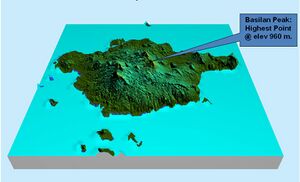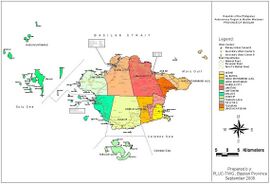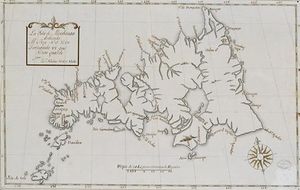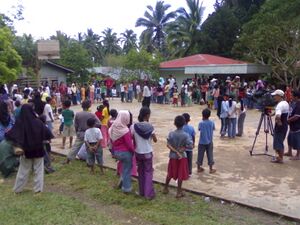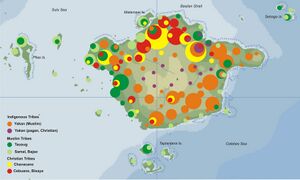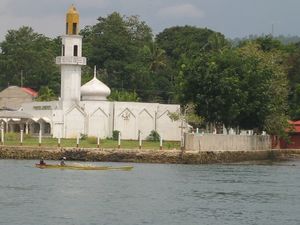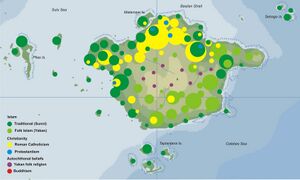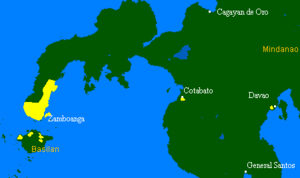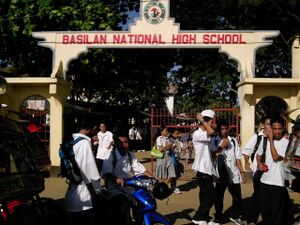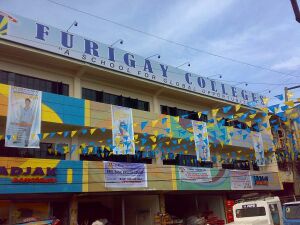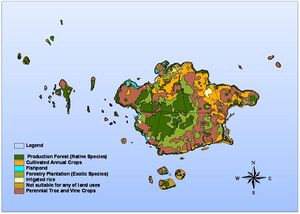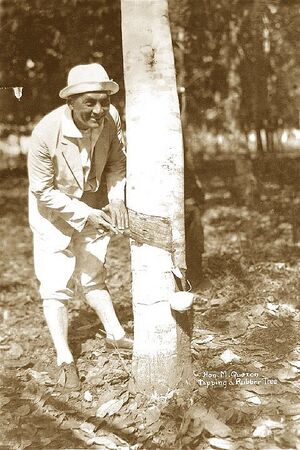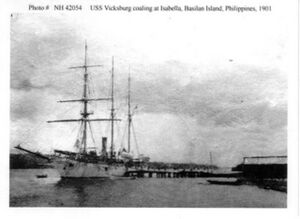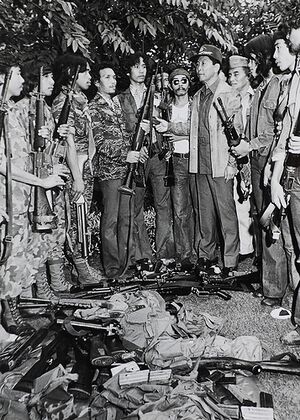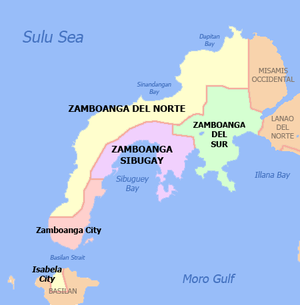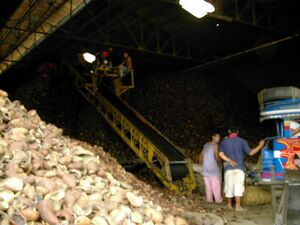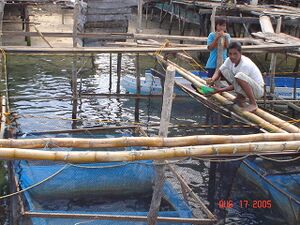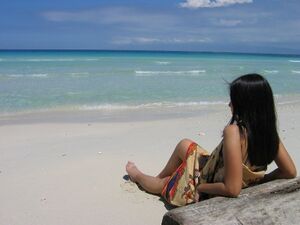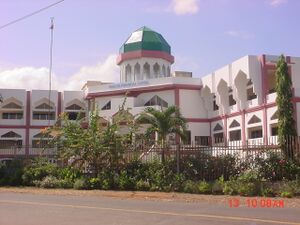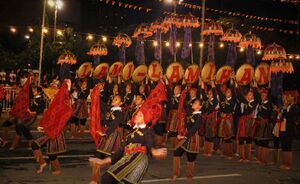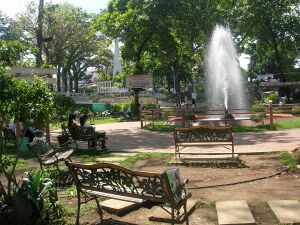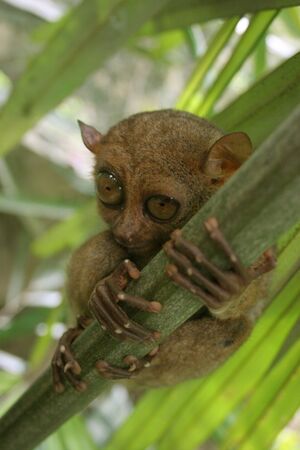باسيلان
باسيلان
Basilan | |
|---|---|
| مقاطعة باسيلان | |
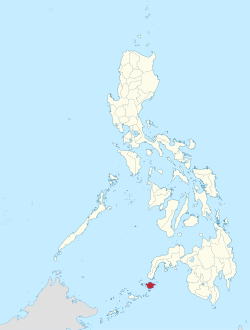 الموقع في الفلبين | |
| الإحداثيات: 7°N 122°E / 7°N 122°E | |
| البلد | |
| المنطقة | قالب:Country data Bangsamoro (Whole province except Isabela) شبه جزيرة زمبوانگا (Isabela only) |
| مدينة ذات ميثاق | 1 يوليو 1948 |
| تحولت إلى مقاطعة | 27 ديسمبر 1973 |
| العاصمة | لاميتان[1] |
| Largest city | Isabela |
| الحكومة | |
| • Governor | Hadjiman S. Hataman-Salliman (PDP-Laban) |
| • Vice Governor | Yusop T. Alano (PDP-Laban) |
| • Representative | Mujiv S. Hataman (LP) |
| • Legislature | Basilan Provincial Board |
| المساحة | |
| • الإجمالي | 1٬327٫2٬358;//data.marefa.org/entity/Q91٬546 كم² (Formatting error: invalid input when rounding ميل²) |
| ترتيب المساحة | 72nd out of 81 |
| أعلى منسوب | 998 m (3٬274 ft) |
| التعداد (خطأ: زمن غير صحيح. تعداد السكان) | |
| • الإجمالي | 556٬586 |
| صفة المواطن |
|
| Divisions | |
| • Independent cities | 0 |
| • Component cities | |
| • Municipalities | |
| • Districts | Legislative district of Basilan |
| منطقة التوقيت | UTC+8 (PST) |
| ZIP code | 7300–7306 |
| IDD : مفتاح الهاتف | +63 (0)62 |
| ISO 3166 code | PH-BAS |
| Languages | |
| Income classification | 3rd class |
| الموقع الإلكتروني | www |
Basilan, officially the Province of Basilan (قالب:Lang-cbk; قالب:Lang-yka; قالب:Lang-tsg; تگالوگ: Lalawigan ng Basilan) is an island province of the Philippines located primarily in the Bangsamoro Autonomous Region. Basilan Island is the largest and northernmost of the major islands of the Sulu Archipelago. It is just off the southern coast of the geographic Zamboanga Peninsula.[3][1]
Isabela, the former capital, is a component city under the provincial government of Basilan but is administered as part of the Zamboanga Peninsula Region and is listed statistically independent. The provincial capital has since been transferred to Lamitan. Despite this, the provincial Capitol and government offices are still located at Isabela.[4]
Basilan is home to three main ethnolinguistic groups: the indigenous Yakans, and the later-arriving Tausugs and Chavacanos. The Yakans and Tausugs are predominantly Muslim, while the Chavacano are mainly Christian. There are also a number of smaller ethnic groups. Although the official languages are Tagalog and English, the main native language is Yakan and lingua franca is Chavacano. Other languages include Tausug, Cebuano, and Sama.
Basilan, although classified as a 3rd-class province in terms of gross provincial income, has one of the lowest incidences of poverty in the Philippines (26.19% of the general population), ranked 20 among the Philippines' 80 provinces. (In comparison, Maguindanao which is ranked last at number 80 has a poverty incidence of 44.24%.) The gap between Basilan's rich and poor residents are among the narrowest in the country (ranked 3rd nationwide), pointing to one of the most equitable distributions of wealth anywhere in the country (Gini coefficient 0.2826, which is slightly better than the provinces of Pampanga, Bulacan, Nueva Ecija, Tarlac, Cavite, Batanes and Batangas).
. . . . . . . . . . . . . . . . . . . . . . . . . . . . . . . . . . . . . . . . . . . . . . . . . . . . . . . . . . . . . . . . . . . . . . . . . . . . . . . . . . . . . . . . . . . . . . . . . . . . . . . . . . . . . . . . . . . . . . . . . . . . . . . . . . . . . . . . . . . . . . . . . . . . . . . . . . . . . . . . . . . . . . . .
الجغرافيا
Basilan is located between latitudes 6°15' and 7°00' and longitudes 121°15' and 122°30'. The island is bordered by the Basilan Strait to the north, the Sulu Sea to the northwest and west, the Moro Gulf to the northeast, and the Celebes Sea to the south, southeast and east.
Basilan is the largest and northernmost island of the Sulu Archipelago between the Philippine islands of Mindanao and Borneo which includes about 400 islands. Basilan Strait, about 17 nautical miles (31 km) at its narrowest point, separates Basilan Island from the mainland of Mindanao and the port city of Zamboanga. The terrain of the island is simple, with several undulating slopes concentrated around Isabela City along the coastal areas and hilly towards the interior. Urban areas are usually 2.5 metres (8 ft 2 in) above sea level and gently sloping to 300 metres (980 ft) toward the hinterlands. The stand of timber and forest vegetation is more or less evenly distributed throughout.
The province encompasses Basilan Island and all nearby offshore islands, together with the Pilas Island group (now Hadji Muhtamad Municipality) west of the island, and the Bubuan and Tapiantana Island group (now Tabuan-Lasa Municipality) in the south. These are listed among the Philippine islands with a moderate risk of getting hit by tsunamis. The province has a land area of 132,723 hectares (327,970 acres) under its jurisdiction.[2] Basilan Island itself has an area of 1,265.5 square kilometres (488.6 sq mi) and a shoreline of 169.8 kilometres (105.5 mi).[5]
Basilan National Park is at the eastern portion of the remaining public forest between the city of Isabela and the municipalities of Lamitan, Tipo-Tipo and Sumisip. The park has an elevation of 971 metres (3,186 ft) above sea level, and the tallest peak, Puno Mahaji or Basilan Peak, dominates the park's landscape.
المناخ
| Climate data for باسيلان، الفلپين | |||||||||||||
|---|---|---|---|---|---|---|---|---|---|---|---|---|---|
| Month | Jan | Feb | Mar | Apr | May | Jun | Jul | Aug | Sep | Oct | Nov | Dec | Year |
| Record high °C (°F) | 39 (102) |
42 (108) |
37 (99) |
41 (106) |
37 (99) |
42 (108) |
40 (104) |
38 (100) |
41 (106) |
37 (99) |
37 (99) |
38 (100) |
42 (108) |
| Mean daily maximum °C (°F) | 28 (82) |
27 (81) |
27 (81) |
28 (82) |
28 (82) |
28 (82) |
28 (82) |
27 (81) |
28 (82) |
27 (81) |
27 (81) |
27 (81) |
27 (81) |
| Mean daily minimum °C (°F) | 24 (75) |
23 (73) |
23 (73) |
24 (75) |
24 (75) |
25 (77) |
24 (75) |
24 (75) |
24 (75) |
24 (75) |
24 (75) |
23 (73) |
23 (73) |
| Record low °C (°F) | 17 (63) |
17 (63) |
20 (68) |
13 (55) |
21 (70) |
20 (68) |
17 (63) |
21 (70) |
15 (59) |
13 (55) |
21 (70) |
20 (68) |
13 (55) |
| Average precipitation cm (inches) | 4 (1.6) |
5 (2.0) |
4 (1.6) |
5 (2.0) |
9 (3.5) |
12 (4.7) |
13 (5.1) |
12 (4.7) |
13 (5.1) |
16 (6.3) |
11 (4.3) |
8 (3.1) |
119 (47) |
| Source: Weatherbase[6] | |||||||||||||
The climate is similar to other areas in the Zamboanga Peninsula. The annual average rainfall is 1,100 millimetres (43 in) and the mean annual temperature is 26.6 °C (79.9 °F). The source of the rainfall is the southwest monsoon and the island's location in the Intertropical Convergence Zone. The climate is classified as a tropical wet and dry climate or Aw using the Köppen climate classification system.
Basilan is outside the typhoon belt. Prevailing winds are from the southwest with a speed of 4 knots (7.4 km/h).
March to May is hot and dry, with temperature averaging 22 °C (72 °F). June to October is rainy. November to February is cool, with temperatures ranging from 22 °C (72 °F) to 28 °C (82 °F). Average humidity year-round is 77%.
التقسيمات الإدارية
Basilan is subdivided into 11 municipalities and two cities.
Isabela, on the northern shore of Basilan Island facing Zamboanga City, is a component city and then capital of the province from 1975 to 2017. Isabela votes for provincial officials, shares its tax revenues with the province, and continues to be under the jurisdiction of Basilan for the administration of provincially devolved services and functions. However, for the administration of regional services, the city is part of the Zamboanga Peninsula Region, while the rest of Basilan in the Bangsamoro Autonomous Region in Muslim Mindanao.
Basilan used to be part of Western Mindanao (the former name of Zamboanga Peninsula) but, in a recent plebiscite, the residents of some parts of Basilan opted to join ARMM, with the exception of Isabela. Originally called Pasangen (the rough English translation is "town") by natives, it still hosts the Basilan Provincial Capitol, the Governor's Executive Residence, the provincial offices of the executive departments and line agencies as well as most of the municipal offices of its neighboring municipalities. Starting in 1848 it was officially renamed Isabela de Basilan, derived from the Spanish fort built on the area where the present Provincial Capitol now stands — Fort Isabella Segunda — which, in turn, was named after Spanish Queen Isabella II. It was renamed Isabela Municipality in 1973 and formally as the City of Isabela on April 25, 2001.
Lamitan became a city in July 2007, although it remains in the ARMM. It is on the northeastern coast of Basilan, where most of Basilan's plains are. Lamitan is experiencing a renewed economic vigor that continues to power the rest of the province's otherwise lackluster growth. A November 18, 2008 decision of the Supreme Court, however, effectively voided the law converting Lamitan to a city after the League of Cities of the Philippines filed a petition earlier in the year. With 16 other local government units, Lamitan's cityhood was again voided in a Supreme Court decision handed down on August 26, 2010, returning it to the status of municipality. On February 17, 2011, the supreme court upheld for the third time the cityhood of Lamitan and 15 other towns in the Philippines.
Lamitan was proclaimed the new capital of Basilan since 2001, when Isabela opted out of the ARMM in a plebiscite held that year. Most provincial offices of the ARMM for Basilan are in Lamitan. Lamitan derives its name from Sultan Kudarat's capital town in the Mindanao mainland — Ramitan. The Iranun Sultan built a fortified base in the area to serve as a staging ground for raids on Spanish Zamboanga. The native Yakans regarded this as "a place where people from Ramitan stayed" or Kuta Ramitan. Eventually, the wooden fortress was razed to the ground by Gov. Gen. Corcuera in 1637. Natives just called the place "Ramitan", and substituting 'R' with 'L', the place gradually became known as simply Lamitan. It became the province's capital since 2017.
The other five original municipalities are:
- Maluso is on the island's southwest, facing the bigger island of Sulu and Tawi-Tawi further south. Its busiest trading port is at Port Holland and Maluso Townsite. According to official accounts, the place derived its name from Spanish "mal uso" (trans. "bad manners"), after the supposedly crude manners of the natives of the place when they established their presence there in the later part of the 19th century.
- Lantawan is in the island's westernmost area. It is mostly an agricultural area for copra and rubber production. Its biggest population concentration is Tairan. It has no major port. "Lantawan" is derived from the native root word "lantaw" (trans. "look"), named after Basilan's westernmost peninsula's sloping hills which served as "lookouts" for natives who observed Tausug and Spanish vintas and ships pass by en route to another raid or naval attack on Jolo or Zamboanga.
- Sumisip is the biggest municipality in land area and hosts what used to be the biggest rubber plantation (Sime Darby) in the Philippines.
- Tuburan is on a peninsula on the extreme eastern part of the island, one of the least developed municipalities and severely devastated by the decades-old armed conflicts plaguing the island. "Tuburan" is rooted in the native word "tubod" (trans. "water spring"), as there is said to be a spring in the area.
- Tipo-Tipo, the last of the original municipalities created by the presidential decree of Ferdinand Marcos, is on the island's southeast coast. It is mostly undeveloped and witness to much of the running gun battles on the island. The place is named after the native word "Tipun-tipunan" (trans. "gathering place"), owing to its tendency for natives of the area to converge in this spot to exchange goods and food stuff with each other.
The latest six municipalities are creations of the regional legislature of the ARMM:[بحاجة لمصدر]
- Akbar (MMA Act No. 193), separated from Tuburan municipality in 2005, named after a political strongman, the late Congressman Wahab Akbar
- Al-Barka (MMA Act No. 191, ratified in 2006)
- Hadji Mohammad Ajul (MMA Act No. 192, ratified in 2006), from Tuburan, named after the first mayor of Tuburan
- Hadji Muhtamad (MMA Act No. 200, ratified in 2007), named after the father of late Wahab Akbar and separated from Lantawan
- Tabuan-Lasa (created by virtue of MMA Act No. 187, ratified in 2008) was separated from Sumisip and is named after the main islands of Tapiantana, Bubuan, Lanawan and Saluping.
- Ungkaya Pukan (MMA Act No. 190, ratified in 2006), named after Orang Kaya Pukan, ancestor of the Akbar family and nemesis of Datu Kalun
The new municipalities were created without the consent of the Philippine Congress. According to some accounts, said municipalities do not reach the basic requirements for the creation of a separate municipality (50 square kilometres (19 sq mi) area, P2.5 million income, and 25,000 population) under the Philippines' Local Government Code. (Recent Supreme Court rulings nullified the creation of Shariff Kabunsuan Province, created by the same ARMM Regional Assembly, reverting it to the 1st District of Maguindanao Province.) As a result, four of the six new municipalities have not been included in the government's annual budget as approved by Congress and have not received any nationally funded Internal Revenue Allotments (IRA) since their creation. These are Hadji Muhtamad, Mohammad Ajul, Al Barka and Akbar municipalities.
| |||||||||||||||||||||||||||||||||||||||||||||||||||||||||||||||||||||||||||||||||||||||||||||||||||||||||||||||||||||||||||||||||||||||||||||||||||||||||||||||||||||||||||||||||||||||||||||||||||||||||||||
. . . . . . . . . . . . . . . . . . . . . . . . . . . . . . . . . . . . . . . . . . . . . . . . . . . . . . . . . . . . . . . . . . . . . . . . . . . . . . . . . . . . . . . . . . . . . . . . . . . . . . . . . . . . . . . . . . . . . . . . . . . . . . . . . . . . . . . . . . . . . . . . . . . . . . . . . . . . . . . . . . . . . . . .
History

Several waves of Negrito and Austronesian migrations populated the Philippines. The Yakan people arrived in the area of the Sulu Archipelago, of which Basilan is a part, around 300 BCE to 200 BCE. Little is known of them before the era of Spanish colonization, but they still make up the largest ethnic group on the main island of Basilan. It is believed that the Yakan people of Basilan made contact with the Kingdom of Champa in present-day Vietnam, and many of them have ancestries from Champa settlers, who later integrated with the Yakan.
As the Tausug Sultanate of Sulu grew in power, the Yakans withdrew inland, until most of the coastal communities along the island's southern, western and northwestern shores were primarily inhabited by Tausugs and their vassal tribes, the Samals and Bajaus (Tau-Laut). The only exception was the relatively prosperous Yakan communities of Lamitan.
Basilan first came to European attention when it was documented by the remnants of the Ferdinand Magellan expedition in 1521. It was eventually colonized by the Spanish as early as 1636 and was formally ceded by the Sulu Sultanate to Spain in 1726. The withdrawal of the Yakans inland was hastened by Spanish establishment of advance bases on the island's northwestern coast, bringing in Christianized 'indios' from Zamboanga, the Visayas and Luzon. By then, even the Yakan communities of Lamitan were completely overrun. Jesuit missionaries brought Catholicism to the region. Fighting with the Sultanate, the Dutch East India Company, Moro Pirates, and the French figured in Basilan's history over the years.
With its victory in the 1898 Spanish–American War, the United States gained possession of the Philippines. Americans proceeded to 'pacify' Basilan, cleared large expanses of land, and established plantations, mainly to produce rubber and copra.
Following the Japanese occupation of the country during World War II, in 1946, the Philippines gained its independence. Beginning around 1970, heavy fighting broke out between the Philippine government and the Moro National Liberation Front, which was determined to secede and form a new country.
In 1973, Basilan officially became a province carved out in the Province of Zamboanga del Sur. It joined the Autonomous Region in Muslim Mindanao in 2001, the last province to do so. Its former capital, Isabela City, opted out and remains a part of the Zamboanga Peninsula Region (formerly Western Mindanao, Region 9).
أصل الاسم
Oral traditions of the local Yakan people include several names for pre-historic Basilan: "Uleyan", which is derived from the present-named Basilan Peak (Puno Mahaji), and later changed to "Matangal" after a mountain farther to the east of the island. These names were presumably used by the Maguindanao traders from mainland Mindanao, using these mountains as navigation landmarks when sailing the Celebes Sea.
Other names romantically given were "Puh Gulangan" or "island of forests", "Umus Tambun" or "fertile land", "Kumalarang" after the westward flowing river on the island's western half which is otherwise called Baunuh Peggesan.
تاگويما
Pre-Hispanic texts from the royal archives of the Sulu Sultanate referred to the northernmost island of the Sulu Archipelago as Taguima, from the Yakan who were called "Tagihamas" (people of the interior or hinterlands) by the Tausug and Samal peoples who came and settled in numerous scattered communities along Basilan's western and southwestern shores and outlying islets and island groups.
Later references mentioned "Bantilan", probably referring to Maluso, which was established as a major Tausug base by Sulu Sultan Muizz ud-Din (whose princely name was Datu Bantilan).
Imperial Chinese texts mention a "Kingdom of Kumalarang" (from the Yakan "kumalang" or "to sing", owing to the location being a place for celebrations and gatherings) during the Ming Dynasty, believed to be the island which now has a barangay of the same name on its northwestern shores.
The earliest map of the Philippines which made reference to an island labeled "Taguima" was produced by Giacomo Gastaldi,[9] through woodblock prints in 1548. It was subsequently included in the influential travel book of Giovanni Battista Ramusio, the Della Navigatione e Viaggi, which was published between 1556 and 1583 in three volumes. This was followed by Abraham Ortelius's work Indiae Orientalis Insularumque Adiacientium Typus, published in 1573 in a German text edition of the atlas Theatrum Orbis Terrarum by Christophe Plantin in Antwerp. As late as 1719,[10] a map titled "Die philippinische Inseln - Isle Brneo" by Allain Manesson Mallet of Frankfurt, Germany featured an island labeled "Tagyma I."
The process by which all these names became "Basilan" is almost certainly due to miscommunication between the natives and the Spanish, as well as the penchant to engage in editorial license by European map-makers of the era.[بحاجة لمصدر]
Basilan's name may also derive from its iron ore deposits. Tausug warriors and slave-traders from Sulu came to Taguima to purchase high-quality magnetic iron ores, which they used for swords, knives and other blades. This profitable trade, helped in large measure by the establishment of Maluso as a major military-naval base of the Sulu Sultanate, eventually gave the island the distinction of being the source of basih-balan, the Tausug word for magnetic iron. Roughly translated and abbreviated, however, basih-lan means "the iron (magnet) trail" or "the iron way".
When several Tausug warriors were caught by the Spanish in one of their numerous raids on the Zamboanga settlement, Spanish officials supposedly admired the artistry and skill that went into making the warriors' elaborately decorated swords, knives and blades. They asked where these weapons could be bought. From atop the ramparts of the Spanish commandery at the Fuerza del Nuestra Senora del Pilar de Zaragoza (Fort Pilar), the warriors supposedly pointed to the island visible across today's Basilan Strait, and said, simply, "ha basih-lan".
Reports from the Jesuit reducciones in Zamboanga and Pasangen (Isabela) were relayed to Manila, where Spanish cartographer Pedro Murillo de Velarde published Historia de la Provincia de Philipinas de la Compañia de Jesvs. Segvnda parte using the Jesuit printing press at Manila in 1749. It featured a map of the Philippines with the unofficial "I. Basilan". The map was re-published by Leipzig map-maker Nicolaus Bellinn for general European circulation in 1752.
Finally, to represent a clear break from the Habsburg Dynasty (which had ruled Spain for 184 years from 1516 to 1700), the first officially sanctioned Spanish maps of its colonies, including "Las Islas de Mindanao", were commissioned by the Bourbons (1700–present). This particular map of Mindanao, apparently copied from the Nicolaus Bellinn map of 1752, was published by Nicolas Norton Nicols in 1757, featuring "Basilan" and bearing the royal stamp of Spanish Bourbon King Ferdinand VI. It has been called "Isla de Basilan" (Basilan Island) ever since.
السكان
الثقافة
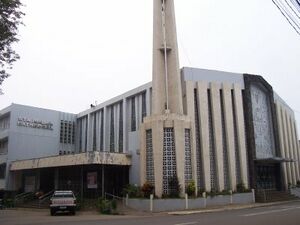
The biggest cultural influences on the island derive from Basilan's tri-ethnolingusitic community: the native Yakan, Tausug, and Chavacano peoples. The Yakans and Tausugs are predominantly Muslim, while the Chavacano are primarily Catholic.
Among the Tausugs and Samals, the phrase "mag-tausug na kaw" means "become a Muslim", instead of the more literal translation, "become a Tausug", as the Tausug ethnic is regarded as the "original Muslims" of the area. Although the majority of the Yakans are Muslims, a significant number conform to traditional local beliefs, traditions and rituals, while a few have likewise opted to be baptized Catholics. Along with a majority of the Chavacano, the Cebuano and the Ilonggo/Hiligaynon Bisaya are also Catholics.
Culturally, the Yakan and the Tausug are distinct ethnolinguistic nations; the Yakan represent the "Lumad" (albeit lately most Yakans have since converted to Islam) or indigenous peoples of Basilan, while the Tausugs, the Samal and the Bajao are regarded as the "original Muslims", and the Chavacano, Cebuano and Ilonggo are the "Cristianos". The rest, a mixture of Ilocanos, Waray, Bicolanos, Maranaos, Iranuns and Maguindanaos, are more recent migrants permanently residing in the region, itinerant merchants or government workers.
This mix of ethnicities, forged first by the Spanish practice of establishing re-settlements or reducciones, as well as the multinational plantations' importation of skilled Christian farm workers and laborers from the Visayas and Luzon, gives Basilan a distinct culture in the Philippines. It is the only predominantly Muslim province that is governed primarily by its indigenous population and whose most commonly spoken language is Chavacano.

The Tausugs and Samals, for the most part having been denied ownership of land, and owing to their primary livelihood of fishing, live along the coastlines, constructing their houses on stilts at the water's edge near population centers. Their houses are, for the most part, outside of the municipal water and sewerage systems of the urban centers. This group controls nearly 100% of the bountiful aquatic resources that surround the island.
The Yakans, on the other hand, having been driven far inland, are scattered throughout the island's interior, in similar raised houses usually made of light materials, but separated from each other. Yakans control nearly all Local Government Units, and since the late 80s have found employment in Government jobs. The Christians are mostly found in the plains, the cities and in the plantations, squeezed between the Tausug-dominated coasts and the Yakan-dominated hinterlands. They make up the bulk of the island's professionals, entrepreneurs, and lowland farmers. The Christians, however, own most of the arable land, as well as nearly all of the businesses and occupy most of the professions.
Tausug/Samal festivals are usually connected to the sea, celebrating the bounty of the seas, even staging dazzling fluvial wedding parades on colorfully bedecked vintas and paraws, a nod to the Tausugs' former naval prowess. Catholic fiestas are almost always related to good harvests on the farms, as well as saintly miracles against natural calamities and victories against Moro attacks in the past. Yakan festivals, meanwhile, are rooted in older, pre-Islamic rituals such as warrior dances, colorful wedding pageants, and harvest rituals.
Culturally, therefore, the Chavacanos, Cebuanos, and Tausugs have had a close relationship, both professionally as well as in trade and commerce, being regarded as the island's "lowlanders" by the Yakan, who are regarded as "de arriba" by the Chavacanos or "tagihamas" by the Suluanon Tausugs, which roughly translates as "uplanders". Conversely, the Yakan have reason to be suspicious of the intents and motives of their lowland neighbors, having been at the receiving end of slave raids, invasions and punitive attacks from both groups for over 500 years.
With the island's strategic location right at the crossroads of the warring camps of Tausugs and the Spanish, Basilan was divided into three primary spheres of cultural dominance by one of the three groups. Basilan's northern and northwestern coasts, facing the heavily Hispanized Zamboanga City across the narrow Basilan Strait, is culturally Christian, or more precisely Catholic. Basilan's southern and southwestern coastal areas have a distinctly Tausug-oriented culture. The eastern and interior portions of Basilan, on the other hand, isolated for the most part from the Spanish in Zamboanga, and the Tausug from Jolo, are enclaves of the indigenous Yakan.
. . . . . . . . . . . . . . . . . . . . . . . . . . . . . . . . . . . . . . . . . . . . . . . . . . . . . . . . . . . . . . . . . . . . . . . . . . . . . . . . . . . . . . . . . . . . . . . . . . . . . . . . . . . . . . . . . . . . . . . . . . . . . . . . . . . . . . . . . . . . . . . . . . . . . . . . . . . . . . . . . . . . . . . .
السكان
| Year | Pop. | ±% p.a. |
|---|---|---|
| 2007 | 496٬505 | — |
| 2010 | 391٬179 | −7.64% |
By the eve of the Commonwealth era in the Philippines, local census estimates showed that a majority of the people of Basilan were Christian migrants, mostly plantation workers recruited from over Mindanao and the Visayas, and Tausug traders, as well as Samal and Bajau fisherfolk. Only around 5,000 Yakans were counted in the census. Until then, most Yakans preferred not to interact directly with their lowland neighbors.
Statistics from the 2010 Census report ([11]) the following breakdown (out of a total 391,179 population):
- Indigenous Yakan: 161,791 (41.36%)
- Christians, i.e., Chavacano / Visayans (which includes Cebuano and Hiligaynon) / Ilocano, etc.: 128,698 (32.9%)
- Other Muslim Tribes, i.e., Tausug / Samal / Bajao / Iranon: 100,690 (25.74%)
The following figures in this subsection are from the National Statistical Coordination Board, NSCB Philippine Database, Census of 2010,[12] unless otherwise noted.
Basilan' median age was 19 years, lower than the 1995 figure of 25 years.
The sex ratio is almost even. There were 166,413 males and 166,415 females in the 2000 CPH.[مطلوب توضيح] However, there were more females in the 15-to-39 age group and more males in all other age groups.
The economically active population, ages 15 to 64, comprises 55.2% of the population. About 42.3% are young dependents (0 to 14 years old) while fewer than 3% are old dependents (64 years old and older). The overall dependency ratio is 81.2: for every 100 persons ages 15 to 64, there were about 77 young dependents and 4 old dependents.
Married people accounted for 47.76% of the total people 10 years old and over, lower than the 1995 figure (49.11%). Single people comprised 43.80% in 2000, a decrease from 45.71% in 1995. The widowed (4.49%) increased less than one percentage point from the figure registered in 1995 (3.89%). Those with other arrangements increased from 3.87% in 1995 to 4.49% in 2000.
Out of 60,710 housing units in Basilan, 60,699 (99.98%) were occupied by 61,546 households. This rate of occupancy was higher than that of 1990 (95.6%). There was a ratio of 1.01 households for every occupied housing unit or 5.48 persons per occupied housing unit.
A large proportion (94.3%) of the occupied housing units in Basilan in 2000 were single houses. 75.9% of the occupied housing units did not need repair or with minor repair,[مطلوب توضيح] while 17.8% needed major repair. One out of nine occupied housing units was built between 1996 and 2000.
The proportion of occupied housing units with roofs made of galvanized iron/aluminum rose from 23.1% in 1990 to 42.5% in 2000. On the other hand, roofs made of cogon/nipa/anahaw declined from 69.6% in 1990 to 50.3% in 2000. As for the construction material of the outer walls, the use of wood rose from 42.2% in 1990 to 52.4% in 2000.
Out of Basilan's estimated 60,582 families, 19,740 lived in urban areas and 40,842 were rural. Average poverty thresholds province-wide were pegged at Php9,271.00 monthly family income, of which Php10,997.00 was considered the urban threshold and Php8,080.00 the threshold for rural families. 26.20% of the total population was below the poverty threshold: 36.50% of the urban population and 21.20% of the rural.
Poverty incidence is defined as the proportion of families whose income cannot provide for the basic food and non-food requirements called the poverty threshold to the total number of families. According to the ARMM government website, in 2006, Basilan ranked 46th among all provinces, with a poverty incidence of 31.7.[13]
النمو السكاني 2000-2007
Basilan experienced a rapid increase in population; between 2000 and 2007, the population increased by 163,675, from 332,828 to 496,503, which is an annual growth rate of 5٫67%, whereas it only rose by 37,263 between 1995 and 2000, an annual growth rate of 2٫25%. A corresponding increase in the number of households was also registered, from 55,137 in 1995 to 61,546 in 2000. This resulted to an average household size of 5.4 persons, higher than the national average of five.
Of the seven original municipalities in Basilan as of May 1, 2000, Isabela, then capital of the province, was the largest in terms of population with 73,032 persons or 21.94% of the provincial total. It was followed by Lamitan (17.64%), Sumisip (15.23%), Tipo-Tipo (14.50%), and Tuburan (12.78%). Lantawan and Maluso, on the other hand, had less than 10% each.
By 2007, the three biggest local government units (LGUs) saw their shares of the population fall relative to neighboring communities; Isabela City fell to 17.72% of Basilan's total population despite remaining the most densely populated area on the island. Lamitan is now only at 16.53% (-1.11%). Old Sumisip (two municipalities with a population of 71,807), with the biggest aggregate land area, fell to 14.46% (-0.77%). Meanwhile, Old Tipo-Tipo (three municipalities: 83,249 pop.) rose to 16.75% (+2.25%) and is now bigger than Lamitan, while Old Tuburan (three municipalities: 73,942 pop.) is 14.89% (+2.11%) and is now bigger than Old Sumisip. Old Lantawan (two municipalities: 49,270 pop.) is at 9.92%, while Maluso (48,175 pop.) comprises 9.7% of the total.
The seven-year increases are widely disparate, which explains the 2000–2007 percentage figures stated above. In Isabela City, the population growth was 20.47% (+2٫60% per annum; 73,032 in 2000, to 87,985 in 2007), slower when compared to the newly created Akbar Municipality, scene of many of the latest gun-battles between government troops and Moro separatist groups. The municipality's seven-year population growth was 101.42% (+10٫14% per annum; 10,581 in 2000 to 21,312 in 2007). The average aggregate annual population increase in the seven-year period for the ten municipalities and one city that comprise Basilan was 9.12%. By comparison, that of the rest of the Philippines was only 2.3%.
These figures are derived from the National Statistics and Coordination Board and Philippine Statistics Authority.[14][15]
These rapid growth rates have been attributed mainly to the practice of local governments of padding their real population numbers to
- obtain a bigger slice of the Internal Revenue Allotment fund given to Philippine LGUs,
- fulfill minimum requirements set by the Philippine Local Government Code (for the newly created municipalities and Lamitan city)
- as well as a reserve of votes for local political clans from constituencies that "usually" record 100% turn-outs during election periods.[بحاجة لمصدر]
تعداد باسيلان 2010
The rapid growth between 2000 and 2007 is replaced by a drastic reduction in the 2007–2010 figures after the previous figures were subjected to stricter statistical analyses, reflecting a more statistically plausible growth trajectory from 2000 to 2010.
As a result, Basilan's 2010 population declined from 496,503 to 391,179, a contraction of 105,324 or -21.21%, a PGR of −8٫31%.
Out of Basilan's two Cities and 11 Municipalities, only two LGUs registered increases in population:
- Isabela City grew from 87,985 to 97,857, an increase of 9,872 or +11.22% (3٫95% PGR); and
- Tabuan Lasa grew from 13,384 to 18,635, an increase of 5,251 or +39.23% (12٫80% PGR).
The rest recorded drastic declines in population:
- Lamitan City, from 82,074 to 68,996, a decline of 13,078 or -14.86% (−6٫12% PGR);
- Sumisip, from 58,423 to 37,031, a decline of 21,392 or -36.61% (−15٫29% PGR);
- Maluso, from 48,175 to 33,803, a decline of 14,372 or -29.83% (−12٫10% PGR);
- Ungkaya Pukan, from 30,472 to 17,701, a decline of 12,771 or -41.91% (−17٫94% PGR);
- Lantawan, from 28,978 to 20,087, a decline of 8,891 or -30.68% (−12٫49% PGR);
- Tipo-Tipo, from 26,548 to 16,978, a decline of 9,570 or -36.05% (−15٫01% PGR);
- Tuburan, from 26,498 to 18,988, a decline of 7,519 or -28.34% (−11٫42% PGR);
- Al Barka, from 26,229 to 19,523, a decline of 6,706 or -25.57% (−10٫19% PGR);
- Hji. Mohammad Ajul, from 26,132 to 15,962, a decline of 10,170 or -38.92% (−16٫42% PGR);
- Akbar, from 21,312 to 13,369, a decline of 7,943 or -37.27% (−15٫61% PGR); and
- Hji. Muhtamad, from 20,292 to 12,249, a decline of 8,043 or -39.64% (−16٫78% PGR).
الدين
The majority of Basilan's population is Muslim, accounting for 65%. The others are mostly Christian (mainly Roman Catholic), accounting for 33% of the population.[بحاجة لمصدر]
A majority of Basilan's Muslim population (41%) practice Sunni Islam of the Shafi'i tradition, as taught by Arab, Persian, Indian Muslim, and Malay missionaries from the 14th century onwards. A substantial remainder follow a syncretist mix of Islam and Yakan folk customs and traditions exclusively among the native Yakan populations farther inland, and a different version of the same folk Islamic tradition which is practiced by the Bajao in Basilan's outlying islands and surrounding seas.
A majority of Basilan's Muslims are concentrated on the island's southern slopes while Christians reside mostly in the urban centers of Isabela and Lamitan on the island's northern coast, where they constitute a majority. Sizable Christian settlements are also found in the former multi-national plantations, for example Tairan, Lantawan; Tumahubong, Sumisip; Maluso Townsite, Maluso. The rest have a mixture of traditional and autochthonal beliefs.
Relatively newer Islamic sects, mostly brought by returning veterans of the Afghan wars and missionaries from Pakistan's stricter Sufi traditions, referred to as the Tableegh, have been active in propagating what they believe to be a "purer" Islamic way of life and worship. A very small number who have since married into Iranian or Iraqi families have converted to Shiite Islam.
Non-Catholic Christians include Evangelicals, Jesus Miracle Crusade, Episcopalian, and Iglesia ni Cristo (INC), Mormons, Seventh-day Adventists, Jehovah's Witnesses, and other Protestant denominations. Only the most recent Chinese immigrants adhere to Buddhism or Taoism, while most of the older Chinese families have acculturated and have either converted to Christianity or Islam while retaining most of their Chinese beliefs.
The Jesuit mission established in 1637 was replaced by a parish when Basilan was reassigned to the Order of Augustinian Recollects in 1850. The Jesuits regained Isabela Parish from 1860 to 1880, and then lost it again to the Recollects, who administered the parish until 1920, at which time Isabela de Basilan was turned over to diocesan priests until 1930. From 1930 through 1950, the Jesuits returned to Isabela, finally relinquishing their long-held outpost to the Claretian Fathers, who took over from 1951 to 1974.
The Isabela Parish burned to the ground in 1962[مطلوب توضيح] and was rebuilt in 1964 under the aegis of Basilan's first bishop, José María Querexeta, a Spaniard. The cathedral was consecrated to Santa Isabel in 1970, and diocesan priests have since administered the same from 1974 to the present. The cathedral figured prominently in the news, suffering one destructive explosion in a triple bomb blast on April 13, 2010.
The Prelature of Isabela de Basilan was created on October 12, 1963, and comprises all territories constituting the civil jurisdiction of Basilan Province, including Isabela. Its titular patron is Santa Isabel de Portugal.[16]
Bishop Querexeta was succeeded by Bishop Rómulo T. de la Cruz, Basilan's first Filipino bishop, on February 16, 1989, who served until January 10, 2002, when the present bishop, Martin S. Jumoad took over.
اللغة
Basilan is home to several ethnolinguistic groups who have their own native vernaculars; the main ones being Chavacano, Tausug, Yakan, and Cebuano (Bisaya). Chavacano is the primary native tongue of the Christian inhabitants of the island and serves as the lingua franca of Basilan, with 80% of residents being able to speak and understand it.[بحاجة لمصدر] Basilan has the biggest concentration of Chavacano speakers in the Philippines outside of Zamboanga City. Tausug is also widely spoken, especially among the Muslim tribes, and is spoken and understood by approximately 70% of Basilan's population. Cebuano is a preferred third tongue among the Christian tribes and even by Muslim tribes because of the mass influx of Cebuano settlers to Mindanao, especially with the Tau Sūg since Bahasa Sūg, is a Visayan languages and is spoken and understood by approximately 60% of residents. Yakan, the acknowledged native language of Basilan, is used primarily by Yakans, although it is spoken and understood by about 15%-20% of the non-Yakan residents. A lesser percentage can speak or understand Samal/Banguingui and Iranon, which are mostly confined to members of their respective ethnolinguistic groups.
Tagalog and English are used for official business or government transactions. Hokkien Chinese is used by the immigrant Chinese community and their descendants. Arabic is mostly used in Muslim prayers and songs and seldom spoken as an everyday vernacular.
التعليم
Basilan's literacy rate has risen over the past two decades, although it remains one of the Philippines' lowest; 72.23% are considered literate, as opposed to the national figure of 92.6%.
The province has one state college and five private colleges. Basilan State College is located in Isabela and has an extension college in Lamitan and Maluso. Among the private colleges, there is Computer Technologies Institute-Isabela (est. 1997) and The Mariam School of Nursing in Lamitan (est. 2004).
Basilan is served by three school divisions of the Department of Education, one each for Basilan, Isabela, and Lamitan. The first two are headquartered in Isabela City, and the latter is in Lamitan City.
Public and private high schools dot the province. The premier secondary educational institution on the island is Basilan National High School in Isabela, followed by Lamitan National High School in Lamitan. The Claret High Schools of Isabela, Lamitan, Maluso and Tumahubong, and a number of Madaris provide private elementary and secondary instruction. Claret College of Isabela is the only Claretian institution which offers tertiary level education in the Philippines. Other schools offering stand-alone senior high school are Computer Technologies Institute-Isabela and The Mariam School of Nursing, Inc.-Lamitan.
More than 42% of the population five years old and older attended or completed elementary education, 17.3% attended or completed high school, while 1.5% attended or finished post secondary education. Less than 3% possessed academic degrees, while 6.2 percent were college undergraduates. A very small number pursued post-baccalaureate studies. There were more males than females among those who attended or finished elementary (51.1%), high school (50.3%), among college undergraduates (52.0%) and those who took post baccalaureate courses (58.4%). On the other hand, there were more females who attended or completed post-secondary courses (52.9%) and were academic degree holders (52.34%).
الأندية والمنظمات
There are clubs and social organizations in Basilan, ranging from the Junior Chamber International Basilan Inc. (Basilan Jaycees) to the Basilan Motor Club.
الاقتصاد
Poverty incidence of باسيلان
|
Agriculture is the main source of economic livelihood. Basilan's major products include coconut (primarily copra), rubber, coffee, black pepper, and African palm oil. Other crops are palay, corn, cacao and cassava.
The Sulu and Celebes Seas provide fish such as tuna, mackerel, and sardines. Most of these are processed in canning factories in nearby Zamboanga City, General Santos (the Philippines' tuna capital), and Navotas.[بحاجة لمصدر] The island's waters also produce grouper, squid, octopus, and marlin, while fishponds supply milkfish, prawn and shrimp. In addition, seaweed is cultivated along some coastal areas.
The island of Omosmarata in Tuburan (now Mohammad Ajul) is listed among only 15 sites in the Philippines with commercially viable ocean thermal energy potential. The Philippines' ocean thermal resource area is 1000 square kilometers, based on the archipelagic nature of the country. Based on a study conducted by the Philippines Department of Energy, the potential capacity for this resource is estimated to be 265 million megawatts.[18]
Likewise, the Basilan Strait is listed among only eight sites in the Philippines with commercially viable ocean tidal energy potential (along with Bohol/Talibon Strait, Basiao Channel, Surigao Strait, Gaboc Channel, Hinatuan Passage, San Bernardino Strait and San Juanico Strait).[19]
Only the provinces of Basilan, Samar and Surigao have both high ocean thermal and ocean tidal energy potential. Basilan likewise has significant as yet underdeveloped mineral deposits, specifically, iron ore, gold, manganese, copper, and coal.
Alienable and disposable lands cover 862.249 square kilometres (332.916 sq mi), forest lands occupy 406.526 square kilometres (156.961 sq mi), 294.194 square kilometres (113.589 sq mi) are underused, 574.85 square kilometres (221.95 sq mi) are under forest cultivation, while 689.479 square kilometres (266.209 sq mi) are under agricultural cultivation.
Local products include woven cloth and trinkets made by the Yakan tribe. Yakans use fibers from plants such as pineapple for their crafts. The weavers traditionally used extracts from leaves, roots and barks to dye their fibers. However, contact with U.S. Peace Corps workers and Christian Filipinos has influenced Yakan textile art. One influence is the introduction of chemical dyes.[20] The museum of Lamitan displays the colorful and intricate traditional Yakan textiles and highlights of the traditional Yakan festival, Lami-lamihan.
التاريخ المبكر
Basilan's economy has seen wild upswings and downturns over the course of several centuries. Pre-Hispanic Taguima had an economy based on basic subsistence agriculture, mostly root crops. Ancient Chinese texts point to the existence of a "Kingdom of Kumalarang", which presumably was located on the island's northwestern shore, and which traded occasionally with Chinese merchants plying the route to the Spice Islands of the Moluccas and Borneo farther south.
When the Spanish arrived, other crops such as rice and corn were introduced and cultivated, primarily for consumption by the growing Christian settlements of Isabela and Lamitan. Trade with Zamboanga grew tremendously, as most of the settlers' needs were supplied by regular shipments from the busy Zamboanga port.
المزارع متعددة الجنسيات
When the United States assumed control of the Philippines after its victory in the Spanish–American War, it brought about the single biggest change in the local economy. By around 1914, Dr. James W. Strong, a pioneering American plantation owner, cleared vast tracts of land on the island's northern plains (Isabela/Lamitan), and established what became the Philippines' first commercial rubber plantation—the American Rubber Co. Upon consulting with Fr. Zamora, a noted botanist of the University of Santo Tomas in Manila, he decided to start experimenting with rubber plants and in 1910, forming the Basilan Rubber Plantation in partnership with J.M. Menzi Corporation as principal stock holders. Seven years later, he sold out his interest to J.M. Menzi Corporation and started American Rubber Co. backed by San Francisco capital. He started building roads in Basilan with the help of his children. Those roads are now part of the National Highway system in Basilan.
The family and plantation prospered and was visited by such notables as Manuel L. Quezon, President of the Commonwealth of the Philippines, his vice-president Sergio Osmeña, General Douglas MacArthur and assorted Governor Generals and High Commissioners for the Philippines.
The 913-hectare plantation was eventually sold to American multi-national B. F. Goodrich through its local subsidiary American Rubber Plantation Corp. This was followed by investments from British-Malayan firm Sime Darby Corp., which opened their 1,651 hectares (4,080 acres) rubber plantation on the island's southern slopes (Sumisip/Tipo-Tipo).
The success of these large-scale cash crop plantations was emulated by a number of enterprising Filipinos and Spanish-mestizo families from Zamboanga, Negros and Luzon. Among these were Don Juan S. Alano, a Hispano-Chinese mestizo and native of Malolos, Bulacan, who opened the Philippine National Sugar Co. on Malamawi Island in 1921. This eventually became the Basilan Estates, Inc., the only 100% Filipino-owned plantation competing with American and British multi-nationals. It operated the Malamawi Island plantation, which was converted to coconut/copra production, and opened a 1,434-hectare copra plantation on the island's western plains (Tairan, Lantawan), Basilan's third-largest plantation in land area. American logging firms Weyerhaeuser Timber Co. and the American Lumber Co. opened large-scale logging concessions which operated in Basilan's extensive upland virgin forest. Menzi Agricultural Corp., owned by Hispano-German J. M. Menzi, opened a 991-hectare rubber plantation in the southern part of Isabela which eventually expanded to black pepper and palm oil.
The University of the Philippines System was awarded a huge 4,018-hectare land grant by the Philippine government, in Santa Clara, Lamitan. This was eventually taken over by the Marcos-era National Development Corp.
When J. M. Menzi died, he was succeeded at the helm of his substantial business interests by his son and Marcos crony, Hans Menzi. When the younger Menzi replaced the plantation's Swiss-expatriate managers with locals, these managers in turn opened up their own plantations elsewhere on the island. Arnold Winniger, Menzi's Swiss manager, together with the Cuevas-Pamaran-Antonio-Flores clan of Lamitan, cleared the Tumahubong, Sumisip area with their 316-hectare Siltown Realty Corp. Walter Boelsterli, another one of Menzi's Swiss recruits, established the 969-hectare Eurasia Match Inc. plantation around Mangal, Sumisip. An American corporation opened the 1,127-hectare Yakan Plantation in Lamitan. This was eventually sold to JAKA Holdings of Marcos-era Defense Minister and current senator Juan Ponce Enrile. Finally, Dutch-American Donald Wieselski opened another 569-hectare coconut plantation in the Canas, Maluso area. This too was sold off to Eustaquio D. Tan & Sons, Inc. The Wihara Plantation, a Japanese company, opened in the Atong-Atong, Lantawan region. This became the source of many of the coconut varieties planted throughout the island.
By the 1950s and throughout the 1960s, the Chartered City of Basilan, fourth-biggest in the Philippines in terms of land area (after Davao, Puerto Princesa and Zamboanga), was classified as a first-class city. It exported copra, coconut oil, rubber and lumber to California by way of Guam and Hawaii.
A substantial number of expatriate plantation managers, mostly Americans but also Swiss, Germans, Dutch, Russian and even Japanese, Irish, and Swedes lived among and intermarried into the native populace.
The Weyerhaeuser Compound (now Tabuk Barangay) was an exclusive gated community for American expatriates living in Basilan. It had its own airstrip and wharf, and two-storey plantation-style villas set apart by expansive yards. The same sort of exclusive gated communities were put up at the Menzi Compound (Menzi Barangay) for Swiss and German managers, and at the Alano Compound (Dna. Ramona T. Alano Barangay) as well, precursors of modern-day subdivisions and exclusive gated communities in the Philippines.
انتفاضة المورو
The Moro uprising of 1971 affected Basilan's economy. It was led by Moro National Liberation Front (MNLF) originating from Sulu, headed by University of the Philippines lecturer Nur Misuari. This was compounded by the declaration of martial law by President Ferdinand Marcos in 1972, and the decree that created Basilan Province, with its initial complement of ten municipalities (eventually reduced to seven).
Politics took center stage, and the resurgent Yakan uplanders found themselves battling the Tausug lowlanders and their allies. The incessant Yakan-Tausug pocket battles throughout the 1980s culminated in the burning of Isabela City's downtown market in 1987. After several revenge killings, Basilan gained notoriety as the Philippines' "Wild, Wild West". By then, Basilan's economy, along with that of the rest of the nation, was limping along, barely surviving the aftermath of these struggles.
برنامج الإصلاح الزراعي الشامل وظهور أبو سياف
At the onset of the post-Marcos administration of Corazon Aquino, another blow was dealt to Basilan's economy. In 1988, Congress passed a law establishing the Comprehensive Agrarian Reform Program (CARP), which inaugurated a land distribution program, effectively dissolving nearly all of the corporate plantations on the island. CARP applied to Basilan's large multi-national plantations despite the plantation workers' misgivings and the landowners' objections. Almost immediately, the large multi-national corporations withdrew their investments from Basilan, leaving their plantations to ill-equipped farmer beneficiaries, who managed operations in a farmers cooperative format.
The J. S. Alano coconut plantation was converted into the Tairan Agrarian Reform Beneficiaries Association and Multi-Purpose Cooperative (TARBAMC), the University of the Philippines Basilan Land Grant into the Santa Clara Agrarian Reform Beneficiaries Integrated Development Cooperative (SCARBIDC), and the American Rubber (B.F. Goodrich) rubber plantation was converted into the Latuan Agrarian Reform Beneficiaries Association Inc. (LARBAI). The vast tracts of the Enrile-owned Cocoland Plantation, was redistributed as the Lamitan Agrarian Reform Beneficiaries Cooperative (LARBECO). A number of other Agrarian Reform Beneficiaries Cooperatives have likewise taken over most of the small to mid-sized plantations on the island.
The Philippine government's initial rapprochement with the Nur Misuari-led Moro National Liberation Front throughout the 1980s established the 7,281-hectare Basilan Resettlement Area which was set aside for MNLF rebel-returnees and their communities located on the western slopes of Basilan Peak, mostly in northern Sumisip, but also in southern Isabela, and northeastern Maluso. This vast area was eventually subdivided into four Agrarian Reform Cooperatives, all of which were established in 1991.
By the early 1990s, disgruntled youth, influenced by returning mujahideen warriors from the thwarted Soviet invasion of Afghanistan and schooled in more radical schools of thought in Syria, Egypt and Pakistan, banded together to form the Al-Harakatul Al-Islamiyah, better known worldwide as Abu Sayyaf, an extremist group advocating strict Islamic governance similar to Afghanistan's Taliban regime. This group initiated test raids, kidnappings, ambushes and assassinations in some of the more vulnerable communities inland, causing the dispersal of these communities and total breakdown of the inland economy.
As more and more of the group's pioneering leaders were captured or gunned down, the group gradually transformed from being radical ideologues to becoming plain lawless elements or bandits, prone to committing heinous crimes, usually kidnapping for ransom and bombings throughout Mindanao, Palawan (Dos Palmas) and even Malaysia (Sipadan Is.).
The group's founding leader, the radical firebrand Abdurajak Janjalani of Isabela City, is a typical product of Basilan's closely mixed ethnicities and inter-marriages: he is part-Tausug, part-Yakan and part-Ilonggo.
ضمها إلى المنطقة الذاتية فيمندناو المسلمة
The Organic Act for the creation of the Autonomous Region in Muslim Mindanao (ARMM) was passed into law in 1989. A plebiscite held in 14 Mindanao provinces was held in the same year. Basilan initially opted out of the autonomous region. Only Maguindanao (without Cotabato City), Lanao del Sur (without Marawi City), Sulu and Tawi-Tawi joined the ARMM.
More than a decade later, in 2001, a new law expanding the ARMM was passed, and a plebiscite was subsequently held. While Basilan's five Muslim municipalities (Maluso, Sumisip, Lantawan, Tipo-Tipo, Tuburan) opted to join the expanded ARMM, residents of the Christian areas of Isabela City and Lamitan Municipality, chose not to. Even then, only Isabela was not included in the expanded ARMM, having been granted cityhood earlier in the same year. Lamitan joined the five other municipalities, as Basilan was officially incorporated into the expanded ARMM.
Widespread corruption in the ARMM, compounded by corruption at the municipal and provincial levels, further eroded business confidence in the island. This, plus the surge of terrorist activities carried out by Abu Sayyaf and their Jemaah Islamiyah cohorts in the international terrorist network of Al-Qaeda, weakened Basilan's economy further.
The hostage crisis of 2001 further raised questions about Basilan's economic future. Operations by Abu Sayyaf damaged prospects for investment and tourism. However, an increased presence by the Philippine and U.S. militaries through the Balikatan 02-1 Joint Military Exercises and the subsequent death of Abu Sayyaf leaders Khadafi Abubakar Janjalani and Aldam Tilao (aka Abu Sabaya), were followed by investments by the United States through USAID. Projects include the Basilan Tuburan Road Improvement Project and improvements to Lamitan and Maluso Ports. Smaller barangay infrastructure projects, intended to help boost economic growth, are also under development. For instance, authorities are building farm-to-market roads, community and trade centers, water projects, and pedestrian bridges, according to USAID information.
A number of other ODA-funded Non-Government Organizations (NGOs) and People's Organizations (POs) flooded Basilan starting in 2002. These NGOs and POs provided much-needed capital infusion for local entrepreneurs to restart defunct or dying business enterprises. Likewise, improved training and government-funded support were extended to decade-old Agrarian Reform Beneficiaries Cooperatives, effectively improving productivity levels and crop yields. Extensive farm management training in these "Coop" areas have likewise improved business efficiency in the cooperatives.
Currently, Basilan's minimum wage is US$3.20/day for non-agriculture related jobs, and US$2.80/day for agriculture related jobs. There are only 1,203 registered Overseas Contract Workers from Basilan.
عودة المطاط

By 2003, Basilan embarked on large-scale replanting programs covering some 50,000 hectares (120,000 acres) of privately owned and/or cooperative-controlled lands, mainly for rubber and cassava. اعتبارا من 2006[تحديث], the province had 15,503 hectares (38,310 acres) planted, of which 7,148 hectares (17,660 acres) were owned by individual farmers and the rest by cooperatives. The exact land area devoted to rubber could reach over 20,000 hectares (49,000 acres), as there are hundreds of unrecorded small rubber growers and farmers. The provincial government reports that almost half or 7,029.47 hectares (17,370.2 acres) are immature, about a fifth or 3,143.36 hectares (7,767.4 acres) is classed as "less-productive", and a little under a third or 4,880.21 hectares (12,059.3 acres) is described as "productive."
A consortium of agrarian reform beneficiaries has been formed to improve quality and increase production. The Isla Corridor Consortium Agrarian Reform Communities not only sees itself as reviving the rubber industry, it also wants to help in the transformation of the battle-scarred province. The consortium, composed of the United Workers Agrarian Reform Beneficiaries Multipurpose Cooperative, Lamitan Agrarian Reform Beneficiaries Cooperative, Santa Clara, and the Latuan Agrarian Reform Beneficiaries Association, Inc., accounts for a total area of about 6,000 hectares (15,000 acres), some 80% of which is planted with rubber trees.[21]
جوز الهند
Although it is still the biggest single crop produced in the province, coconut/copra production annually was only 193,848 metric tons in 2003, down from its peak production of 189,297,937 metric tons just two years before. Coconut plantations and small coconut farms cover more than 12,000 hectares (30,000 acres), all of which are classified as "productive" to "mature" areas. However, province-wide coconut production, which still accounts for 50%-60% of the province's total economic activity, has dropped precipitously to only 174,939 metric tons in 2002 due to the lingering effects of CARP, combined with a severe onset of the El Niño weather pattern, the worsening threat to peace and order resulting from the resurgent Abu Sayyaf terrorist group and their MILF allies, and the policy of the Akbar administration to replace coconut with rubber trees.
Coconut plantations began to revive in 2006, owing to the steep rise in copra prices. A comprehensive replanting and rehabilitation program is currently being implemented by the Philippine Coconut Authority (PCA) and the Department of Agriculture for the resuscitation of the island's copra production industry, once the Philippine's second-largest copra exporter after Quezon Province in Luzon. To date, however, coconut production in the province, rapidly being replaced by rubber plantations, has remained in the doldrums despite the government's best efforts to revive the ailing sector, such as PCA incentives to coconut farmers.[22]
منتجات أخرى
Basilan's extensive coastline hosts seafarers and fishers, almost all of them Tausugs, Samals and Bajaus, who have been engaged in fishing for several centuries. Annual Basilan fish production is limited to 28,073 metric tons due to resistance to the modernizing of their fishing fleets.[when?]
Only 2,945 metric tons of palay (rice) are produced in Basilan's mostly rolling terrain. Corn production is 1,333 metric tons, bananas 20,458 metric tons, and mangos 211 metric tons.[when?]
There are 155,541 chickens, 5,085 ducks, 7,803 carabaos (water buffalo), 2,724 cattle, 14,470 goats, and 14,700 hogs.[when?]
الصرافة والتمويل
Banks based in Basilan have a total deposit base of more than Php764,500,000. The city hosts at least 27 pawnshop operations, each of whom has an average of three branches, mostly located in Isabela City, Lamitan, and Maluso Townsite.
The province is also serviced by satellite offices of government financing institutions such as the Social Security System and the Government Service Insurance System.
The Basilan business sector is represented by the Philippine Chamber of Commerce & Industry, Inc.-Basilan Chamber (PCCI-Basilan), organized in 1975, the only business support organization duly affiliated with the Philippine Chamber of Commerce & Industry, Inc. (PCCI), with 95% of its members being composed of small and medium enterprises, and offices mostly in Isabela City and Lamitan, but with business assets and operations throughout the island. A number of smaller business groups have since been established catering to the needs of businessmen from specific ethnic or religious affiliations.
المرافق والبنية التحتية والصحة
Basilan's electricity needs are served by the Basilan Electric Cooperative, powered by three diesel-powered electricity generating plants located at Barangay Binuangan, Isabela, one National Power Corporation diesel-powered barge located at Barangay Tabuk, Isabela, and two mini-hydroelectric plants located in Kumalarang, Isabela and Balagtasan, Lamitan. A total of 62 sitios, in 42 barangays spread out in 6 municipalities still do not have access to electricity. Only about 38% of Barangays are sufficiently powered for modern needs, and most of these are located in the cities of Isabela and Lamitan, and Maluso Municipality. Rates are currently pegged at US$0.824/kwH (Php11.42/kwH), one of the highest in the country. Basilan has a total electricity demand of 8.8MW (peak hours), and has a total reliable electricity supply of only 7.4MW, thus resulting in one of the country's longest intermittent blackout spells, running for several years now.
Basilan is served by three local water utilities: Isabela City Water District, Lamitan City Water District, and Maluso Water District. Only 17,693 households, however, have full access to safe and potable water. Current rates are pegged at an average US$3.20/month (+US$0.0826/10 cu.m.)
The island is served by the Provincial Telephone System, which has 600 land-line connections and connected with National Direct Dial via the Philippine Long Distance Telephone Company. It is also served by major mobile telecommunications carriers Globe Telecommunications and Smart Communications. It has two Wi-Fi internet Service provider, and numerous internet cafes.
National roads (concrete, asphalt, gravel) total 131.92 kilometres (81.97 mi), while there are 795.8 kilometres (494.5 mi) of local roads. There are 13 municipal and local ports, three of which have roll-on/roll-off capability, and at least ten private airstrips servicing small aircraft. Major bridges are the Marcos Bridge of Isabela and the recently inaugurated Matarling Bridge (built through USAID funding) between Isabela and Lantawan.
There are 394 Barangay Health Workers and four private hospitals: the Juan S. Alano Memorial Hospital (formerly Basilan Hospital), Infante Hospital, Basilan Community Hospital, all in Isabela, and the Dr. Jose Ma. Torres Hospital in Lamitan. There are also four government-run hospitals: Basilan General Hospital and Isabela City Infirmary, both located in Isabela City, the Lamitan District Hospital in Lamitan City, and the Sumisip District Hospital in Luuk-Bait, Sumisip Municipality.
السياحة
Architectural landmarks include the Santa Isabel Cathedral, the Calvario Peak, on which the Chapel of Peace stands, and the Kaum Purnah Mosque. Natural attractions include the lake in the Panigayan fishing village, Sumagdang Beach and the waterfalls of the Kumalarang River. Cultures can be visited, such as the Badjao, the Yakan, and the Muslim communities.[23]
المساجد والكنائس
- Chapel of Peace, Calvario Peak, Isabela, perched 400 metres (1,300 ft) above sea level and 15 minutes from the town proper.
- Santa Isabel Cathedral, Isabela, an art deco cathedral with a mosaic altar reminiscent of Roman-Byzantine cathedrals, named in honor of the patron saint of Isabela.
- Monte Santo Shrine, atop Mt. Ubit in Lamitan, is a pilgrimage site for devout Catholics who visit the shrine for the traditional "13 Stations" during Holy Week.
- Kaum Purnah Mosque, Isabela, an old and imposing mosque, the sight of which greets visitors on ferries as they sail the channel into Isabela.
المواقع التاريخية
- Datu Kalun Shrine, Lamitan. Built as a tribute to a famous Yakan leader, it is a triangular park located in the heart of Lamitan City's bustling downtown. His descendants include the prominent Cuevas-Pamaran-Antonio clan.
- Museo ng Lamitan, which showcases the Lami-lamihan festival. It also serves as the information center for Lamitan.
- Old Basilan Provincial Capitol, site of Fort Isabela II. The original fort was bombed and destroyed towards the end of World War II, having been used by the occupying Japanese forces as a munitions dump. A newer Capitol Building was built on the spot where the old Basilan City Hall stood after it was burned in the early 1990s. The new building is a celebration of Muslim and Christian influences which shaped modern-day Basilan, and still occupies the highest point of the city proper.
- Isabela City Plaza (formerly Plaza Misericordia) /Plaza Rizal. The twin plazas of the city have remained at the very center of Basilan's socio-political scene to this very day.
الأعياد
- Pakaradjaan Basilan, celebrated annually from March 1 to March 7 to commemorate the founding anniversary of the Province of Basilan.
- Lami-Lamihan Festival, the island's premier festival, is celebrated during the Feast of St. Peter (Fiesta San Pedro) on June 29 in Lamitan City. The festival is highlighted by the Yakans, who attend the festivities in full regalia, selling wares and produce brought in from their farms in the interior.
- 'Cocowayan' Festival, Isabela's annual commemoration of its cityhood, is a week-long series of activities culminating in the annual Street Dancing parade on April 25.
- Fiesta Santa Isabel, celebrated every July 8 by the residents of Isabela, in honor of its Patroness Saint, Elizabeth of Portugal (Span. Santa Isabel de Portugal). The focal point of the celebrations is the Santa Isabel Cathedral, located at the center of Isabela City. This is highlighted by a procession and novena masses, the traditional Bella Isabela Beauty Pageant, a marathon, a regatta and other activities organized primarily by the Diocese of Basilan and the Prelature of Isabela and its lay organizations, the Catholic Women's League and the Knights of Columbus.
- Semana Santa (Holy Week), celebrated in March/April (movable). A city procession known as the Santo Entierro (Holy Funeral) on Good Friday highlights the observance of Lent. Celebrated in most parish churches in the city and in the Santa Isabel Cathedral, the Santo Entierro is a procession of Christ's images, many of the Stations of the Cross along the city's main streets, depicting his last hours before, during, and after the Crucifixion.
- Flores de Mayo (May 1–31). A religious feast celebrated in all Catholic churches in honor of the Virgin Mary. Little children in white gala dresses walk up the altar to offer flowers to the image of the Virgin Mary.
- Fonda de Barangay or Fiestas del Barangay, a week-long celebration in the barangays/barrios honoring their patron saints. The celebration usually starts with novena masses held every day for nine straight days before the feast day of the patron saint. Every night, the barrio is lit up for celebration and merry-making that includes pageants, trade fair, parade, cock-fighting, carnival, musical competition and "baile."
- Budbud Festival, a barangay fiesta in honor of Nuestra Senora dela Regla of Begang Barangay, otherwise known as Isabela's "Little Cebu", a majority of whose residents originated from Carmen, Cebu Province. The festival consists of several days of beauty pageants, street dancing, "budbud" (rice cake) eating and much merrymaking.
- Pascua (Christmas), the December 25 celebration of Jesus Christ's birth. City hall, churches, schools, streetlight post, houses, streets, commercial places, parks and most of the other places in the city are covered with lights, filled with joyous sounds and other Christmas decorations.
- Isra Wal Miraj (May 9), an Islamic event celebrating the nocturnal journey and ascension of Muhammad to Heaven.
- Eid al-Fitr/Hari Raya Puasa (movable), an Islamic event commemorating the end of the Muslim fasting season.
- Maulidin-Nabi (December 27), an Islamic celebration honoring the birthday of Muhammad.
- Chinese New Year, celebrated every February (movable) mostly for the raucous noise-making, tikoy-eating marathons, and the much-anticipated distribution of "ampaw" by rich Chinese godparents.
السياسة
Basilan's politics has been dictated by its economics. Whereas only 33% of the island's residents originate from Christian tribes in the Visayas and Luzon, this group owns 70% of the island's developed arable agricultural land (private ownership or cooperatives as farmer beneficiaries). The Yakan tribe, comprising 41% of the island's population, has full control of local governments outside of Isabela and Lamitan. The Tausugs, Samals and Bajaus, forming 25% of the population, control nearly 90% of the island's aquatic harvest, while the minuscule Chinese segment of the population controls nearly 100% of all commodity trading and commerce activities, especially in the bigger cities.
This volatile mix of ethnic and religious groups have defined political realignments in the island for most of its history. The Christian tribes, traditionally allied with the Tausugs, controlled Basilan politics until the 1980s, when the Yakans, aided by their almost absolute control of the hinterlands and the disappearance of the multi-national plantations, scored upset victories in electoral contests starting in 1988.
This political combine has since seen some in-fighting from two of the most formidable power blocks to have formed since the 2004 general elections. Both blocks went head-to-head in the 2007, 2010 and 2013 local elections with mixed results.
The Akbar block (Liberal Party - Atienza Wing & Lakas-CMD/Kampi) was led by the late Wahab Akbar, three-term Basilan governor and clan patriarch, together with his wives, and his nephews and nieces, all of whom won mayoral posts in all the municipalities as well as Isabela City, which is under his second wife Cherrylyn Santos-Akbar. Hja. Jum Jainuddin-Akbar, the incumbent three-term Governor of Basilan assumed the leadership of the block after Wahab Akbar himself, who was elected congressman in 2007, was assassinated in November 13 of that year. Cases were filed against Gerry Salapuddin ang Mujiv Hataman, having been accused of having master-minded the assassination. The 2013 Elections proved the staying power of the Akbars as the clan, celebrating the twin victories of both Governor Jum and Mayor Cherry, heralded the election of Alfiya Akbar-Fernandez, eldest daughter of Gov. Akbar, as the top-notcher Provincial Board Member for District 1, and Al Qaid Akbar, eldest son, who won as Isabela City Councilor. The Akbars won all of their electoral contests since 1998. Gov. Jum Akbar won in all Cities and Municipalities in Basilan, except Hdji. Muhtamad (Pilas) in the last election, with an electoral landslide of over 60,000 votes against her only opponent. This is her third and final term as governor. Mayor Cherry Santos-Akbar likewise won handily in Isabela for a third and final term in that City.
The Hataman block (Liberal Party) - Roxas/Aquino Wing) is led by Mujiv Hataman, elected Regional Governor of the Autonomous Region in Muslim Mindanao (ARMM) in 2013, a close friend and ally of Philippine President Benigno Simeon Aquino III. He is joined by his brother, Rep. Hajiman Hataman-Salliman, Congressman of the Lone District of Basilan, and his wife, Sitti Djalia Turabin-Hataman who won a seat as a Party-list representative in Congress, representing Anak Mindanao Party-list. They are joined by a number of clan members who likewise won local positions, especially in their bailiwick of Sumisip Municipality in Basilan. The Hatamans can boast of a mixed bag of electoral victories and defeats since 2004. Mujiv Hataman is in his first term as Regional Governor of ARMM, Cong. Jim Salliman is on his second term as Representative, and Cong. Sitti Djalia Hataman is on her first.
The Salapuddin block (Lakas-CMD/Kampi) is led by Abdulgani "Gerry" Salapuddin, three-term governor, three-term congressman and two-term Deputy Speaker of the House of Representatives. To him, the 2007, 2010 and 2013 elections proved to be a débâcle, as he and his daughter - Rabia Salapuddin (who ran for governor in 2013) lost on all fronts. The Salapuddins have lost all elections since 2007.
The Akbars and Hatamans forged a political alliance in 2012, paving the way for the appointment of Mujiv Hataman to the top post at the ARMM. The criminal case against Hataman was voluntarily dropped by the Akbars in 2012, while the Supreme Court threw out the case filed against Salapuddin in 2013. Both Akbar and Hataman coalitions are currently affiliated with the Liberal Party of the Philippines, led by President Aquino. Salapuddin has remained with Lakas-CMD.
المسئولون الحاليون
- Governor: Hadjiman S. Hataman-Salliman
- Vice Governor: Yusop T. Alano
- أعضاء مجلس المقاطعة:
|
|
الانتخابات المحلية الأخيرة
As a result of the 2010 Synchronized National and Local Elections, three major factions emerged: the Akbar block, still formidable, albeit splintered and severely weakened from within after the assassination of clan patriarch, Rep. Wahab Akbar, of the Administration Lakas-Kampi-CMD; the Hataman block, suddenly a potent force to be reckoned with province-wide, under the new administration's Liberal Party; and a third force headed by former Akbar ally and Ungkaya Pukan Mayor Joel T. Maturan, of the Nacionalista Party and former Lakas-CMD stalwart Salapuddin.
Incumbent governor Hja. Jum Jainuddin-Akbar won the gubernatorial race, defeating Mujiv Hataman, with Ungkaya Pukan Mayor and former Akbar ally Joel T. Maturan trailing far behind. The lone congressional district of Basilan, on the other hand, was won by Hajiman Salliman Hataman (LP), who had been defeated by Wahab Akbar in 2007, followed closely by former Deputy Speaker Abdulghani Salapuddin (NP), Lantawan Mayor and Wahab Akbar's niece, Tahira Ismael-Sansawi (PMP), Maluso Mayor Sakib Salajin (Lakas-Kampi-CMD), also a nephew of Wahab Akbar and Rajam M. Akbar, Wahab Akbar's sister.
In the cities, incumbents Cherrylyn Santos-Akbar (Lakas-Kampi-CMD) of Isabela and Roderick Furigay (LDP) of Lamitan both won their respective contests. Isabela City's vice mayoral race proved to be hotly contested, with Tabuk Barangay Chairman Abdulbaki Ajibon winning over the incumbent in a close fight. Lamitan's incumbent Vice Mayor Arleigh Eisma ran unopposed.
The election season once again witnessed a spike in crime, most noticeably a rise in kidnappings, assassinations and ambuscades. On January 29, 2009, at 5:00pm, Al Barka Mayor Karam Jakilan was felled in an ambush, together with two of his personal bodyguards. Earlier, a slew of assassinations in both the Akbar and Hataman camps, most prominently an Akbar henchman and two Hataman cousins, commenced early in 2008. Also, a spate of kidnaps for ransom have been widely observed to peak as election season nears.
On April 13, 2010, two bomb blasts rocked Isabela, the first at the Basilan National High School Grandstand Oval, the second right beside Santa Isabel Cathedral. A third controlled explosion was detonated by elements of the Philippine National Police Bomb Squad a few meters from the Isabela City Hall. This was followed by the massacre of twelve residents of Theresa Heights Subdivision, Barangay Eastside, as the bombers, purportedly members of the Moro Islamic Liberation Front and Abu Sayyaf, escaped from a porous Philippine military cordon.
Local elections have been widely fraught with massive cheating, vote buying and fraud as well. Blame could not be assigned to one particular group or political block alone, as this has been a "common practice" across the political spectrum. The May 2010 automated elections turned out to be no different, with Basilan being designated an "Election Hotspot" by the Philippines' Election Commission. Violent confrontations between political supporters of rival parties, and the failure of Board of Election Inspectors in two villages in Maluso and Al-Barka Municipalities forced authorities to declare a "Failure of Elections" in these parts. Special elections were conducted in these villages on June 3, 2010, where incidents of fraud and minor scuffles were again observed.
May 2013 saw a rematch between the Akbar Block (led by incumbent governor, Jum Jainuddin-Akbar, now affiliated with the administration Liberal Party - LP), against Salapuddin (led by a young Rabia Salapuddin, daughter of former governor and Congressman Abdulgani "Gerry" Salapuddin, Lakas-CMD).
In this electoral contest, the Akbars allied with erstwhile political rivals, the Hatamans (led by Mujiv Hataman, who ran as Regional Governor of the Autonomous Region in Muslim Mindanao, and his brother, Rep. Jim Hataman-Salliman, Liberal Party), resulting in one of the most lop-sided election landslides in recent memory. Governor Akbar won her re-election bid with a record-breaking 60,000-vote margin against her only challenger, the younger Salapuddin. She is joined by Vice Governor Keemhar Jay Reynon Sakkalahul (LP) who bested a field of five Vice-Gubernatorial contenders. The son of former Basilan Vice Governor Al-Rasheed Sakkalahul, the new Vice Governor is currently the youngest Vice Governor in the Philippines, at 23 years old. Mayor Cherrylyn Santos-Akbar also won another lopsided victory in Isabela City.
The Akbar Block has likewise added two new contenders, the Governor's children - daughter Alfiya Akbar-Fernandez - who topped the Provincial Board Members' tally for District I, while son Al Qaid Akbar managed a third-place debut in local politics as an Isabela City Councilor. The provincial sweep of the Liberal Party was complete in 2013. All winning Provincial Board Members, from Districts 1 and 2 came from the LP, while 11 of 13 Mayors are LP members.
LP ARMM Standard-bearer Mujiv Hataman also won his own contest in the autonomous region - making him the first Basileño to win the region's top post in an election. LP re-electionist Congressman Jim Hataman-Salliman, his brother, likewise reclaimed his seat in Congress. Moreover, Basilan-founded Anak Mindanao Party-list is returned to the House of Representatives, with Mujiv Hataman's wife, Sitti Djalia Turabin Hataman, becoming a Party-list Representative. Elder brother Gulam Hataman is returned unopposed as Sumisip Mayor.
قائمة الحكام السابقين
Governors after People Power Revolution 1986:
- 1986 - 1989,
- 1989 - 1992, Abdulgani Salapuddin
- 1992 - 1995, Abdulgani Salapuddin
- 1995 - 1998, Abdulgani Salapuddin
- 1998 - 2001, Wahab Akbar
- 2001 - 2004, Wahab Akbar
- 2004 - 2007, Wahab Akbar
- 2007 - 2010, Jum Akbar
- 2010 - 2013, Jum Akbar
- 2013 - 2016, Jum Akbar
- 2016 - 2019, Hajiman Hataman-Salliman
- 2019 - present, Hajiman Hataman-Salliman
Vice Governors after People Power Revolution 1986:
- 1986 - 1989,
- 1989 - 1992, Ping Kasim
- 1992 - 1995, Ping Kasim
- 1995 - 1998, Ping Kasim
- 1998 - 2001, Bonnie Balamo
- 2001 - 2004, Lukman Ampao
- 2004 - 2007, Al-Rasheed Sakkalahul
- 2007 - 2010, Al-Rasheed Sakkalahul
- 2010 - 2013, Al-Rasheed Sakkalahul
- 2013 - 2016, Keehmar Sakkalahul
- 2016 - 2019, Yusop Alano
- 2019 - present, Yusop Alano
Bellwether Province
In the last five presidential elections, Basilan voted for Ferdinand Edralin Marcos (1965, 1969), Corazon Cojuangco Aquino (1986), Fidel Valdez Ramos (1992), Joseph Ejercito Estrada (1998), and Gloria Macapagal-Arroyo (2004), all of whom won in their respective bids. Similarly, Basilan's vice presidential choices, namely Fernando Lopez (1969), Salvador Laurel (1986), Joseph Ejercito Estrada (1992), Gloria Macapagal-Arroyo (1998) and Noli De Castro (2004), also won, making it one of the most accurate bellwether provinces in Philippine politics today. Sen. Manuel Roxas II was Basilan's Senate top-notcher[مطلوب توضيح] in 2004, while Sen. Loren Legarda was number one in 2007. The recently conducted May 2010 national/local polls manifested once again Basilan's uncanny record of picking the winners, Benigno S. Aquino III (Liberal Party) and Jejomar C. Binay (PDP-Laban) won in the presidential and vice presidential contests in the Province respectively.
However, Basilan has figured prominently in a number of election-related issues in the past, the foremost being its inclusion among the provinces (together with Cebu and the rest of the ARMM provinces) where, allegedly, former Philippine President Gloria Macapagal-Arroyo committed wholesale election fraud to win the 2004 presidential elections. The ensuing imbroglio, dubbed the "Hello Garci" Scandal, included several mentions of Basilan and its late governor, Wahab Akbar, in taped conversations purportedly between President Arroyo and COMELEC Commissioner Virgilio Garcillano.
النبيت والوحيش
The island chain is one of two partial land bridges to Borneo and is an important migration route for birds. Among the species of flora and fauna found in Basilan are:
Mammals
- The Basilan flying squirrel (Petinomys crinitus), a species of rodent in the family Sciuridae. It is endemic to the southern Philippines, and found extensively in Basilan.
- The Philippine tarsier (Tarsius syrichta), a near-threatened tarsier species endemic to the Philippines.
البرمائيات
- The Basilan Island caecilian (Ichthyophis glandulosus), a species of amphibian in the family Ichthyophiidae. It is endemic to the Philippines.
الطيور
- The yellow-wattled bulbul (Pycnonotus urostictus), found and documented in the Philippines, specifically Isabela, Basilan, on November 15, 1887, by Moseley, E. L. Published by Steere, J. B. in a list of the birds and mammals collected by the Steere expedition to the Philippines.
- The Basilan tarictic hornbill (Penelopides panini basilanicus), a variant of Penelopides affinis basilanicus (Tweeddale, 1877). Also published by Steere, J. B., in a list of the birds and mammals collected by the Steere expedition to the Philippines.
- The Everett's white-eye basilanicus (Zosterops everetti basilanicus), with distribution throughout the Philippines, but more extensively in Basilan, Dinagat, Mindanao, Siargao, and Camiguin. (Everett's white-eye, Tweeddale, 1878)
النباتات
- The Dipterocarpus basilanicus tree, lofty, emergent, with grayish brown to orange, flaky, prominently lenticellate bark and aromatic oily white resin, with stout buttresses.
في الثقافة الشعبية
The Basilan Island was also featured in the 2004 video game Counter-Strike: Condition Zero as a map in Lost Cause, the second mission of the game. Counter-Strike: Condition Zero is a multiplayer video game that follows to Counter-Strike.
الإعلام
الصحف
أشخاص بارزون
- Wahab M. Akbar: former political kingpin and dynast, three-term governor, elected congressman in 2007, killed by a bomb blast at the House of Representatives in November 2007.
- Mujiv Sabbihi Hataman: former Anak Mindanao Party-list Representative and Regional Governor (Officer-in-Charge) of the Autonomous Region in Muslim Mindanao (ARMM) from December 2011 until June 2013, appointed by Philippine President Benigno S. Aquino III, after regular elections in August 2011 were postponed to coincide with the Synchronized National and Local elections of May 2013.
- Regino C. Hermosisima, Jr.: Supreme Court justice, presided over the Aquino-Galman double murder case as a judge at the Manila RTC.[مطلوب توضيح] Chairman emeritus of the Philippine Young Men's Christian Association.
- Abdulgani A. Salapuddin: former MNLF[مطلوب توضيح] commander, schooled at the Sorbonne University in Paris, France, became three-term governor, then three-term congressman, the last two times as the elected Deputy Speaker of the House of Representatives.
- Cecile Licad: concert pianist, lived in Basilan with her father Dr. Jesus Licad, who helped establish Basilan Hospital (now J. S. Alano Memorial Hospital).
- John Estrada: movie and TV actor, starred roles both as leading man and villain, currently on contract with ABSCBN TV2 Manila and TV5.
- Shamcey Gurrea Supsup: 2011 Binibining Pilipinas, Universe, third runner-up Miss Universe 2011 and current national director of Miss Universe Philippines .
انظر أيضاً
المراجع
- ^ أ ب "ARMM to put up new Basilan capitol". philstar.com.
- ^ أ ب ت 'Bangsamoro Development Plan'. Bangsamoro Development Agency. 2015. p. 95. ISBN 9786219520928. See also talk page
- ^ "Archived copy". Archived from the original on 2017-08-11. Retrieved 2017-05-14.
{{cite web}}: CS1 maint: archived copy as title (link) - ^ "Basilan Province Official Website - Contact us" (in الإنجليزية الأمريكية). Archived from the original on 2017-10-24. Retrieved 2021-06-22.
- ^ "Islands of Philippines". Island Directory. United Nations Environment Programme. Retrieved 20 August 2014.
- ^ "Weatherbase: Historical Weather for Basilan, Philippines". Weatherbase. May 2011. Retrieved 21 January 2009.
- ^
Census of Population (2015). Highlights of the Philippine Population 2015 Census of Population. PSA. Retrieved 20 يونيو 2016.
{{cite encyclopedia}}: Cite has empty unknown parameter:|chapterurl=(help)CS1 maint: numeric names: authors list (link) - ^
Census of Population and Housing (2010). Population and Annual Growth Rates for The Philippines and Its Regions, Provinces, and Highly Urbanized Cities (PDF). NSO. Retrieved 29 يونيو 2016.
{{cite encyclopedia}}: Cite has empty unknown parameter:|chapterurl=(help)CS1 maint: numeric names: authors list (link) - ^ Early Mapping of Southeast Asia في كتب گوگل
- ^ "Antique, old, rare and historic Maps & Prints of Southeast Asia". Bergbook.com. Retrieved 2008-10-05.
- ^ "PIA | Philippine Information Agency | 2010 population in ARMM down by…". Archived from the original on 5 August 2012.
- ^ "Philippine National Statistical Coordination Board (NSCB)". Nscb.gov.ph. Archived from the original on 3 October 2008. Retrieved 2008-10-05.
- ^ "Poverty Situation". Autonomous Region in Muslim Mindanao. Retrieved May 12, 2011.
- ^ "NSO Basilan Quickstat". Census.gov.ph. Archived from the original on 2008-11-19. Retrieved 2008-10-05.
- ^ "NSCB - Active Stats - PSGC Interactive - Province: BASILAN". Nscb.gov.ph. Archived from the original on 19 November 2008. Retrieved 2008-10-05.
- ^ "The Prelature of Isabela de Basilan". Cbcponline.net. Archived from the original on 2010-05-13. Retrieved 2008-10-05.
- ^ "Poverty incidence (PI):". Philippine Statistics Authority. Retrieved December 28, 2020.
- ^ "OCEAN THERMAL ENERGY POTENTIAL SITES". Department of Energy (Philippines). Archived from the original on 2009-01-05. Retrieved 2008-10-05.
- ^ "OCEAN TIDAL ENERGY POTENTIAL SITES". Department of Energy (Philippines). Archived from the original on 2011-05-04. Retrieved 2008-10-05.
- ^ أ ب "Department of Tourism - The Philippines Ultimate Travel Guide for Tourist". www.visitmyphilippines.com.
- ^ "Basilan rubber sector eyes rebirth". GMANews.TV. 2008-05-28. Retrieved 2008-10-05.
- ^ Carbayas, Rene V. (2008-05-12). "Isabela coconut farmers get incentives from PCA" (Press release). Philippine Information Agency. Retrieved 2008-10-05.
- ^ "Basilan - A Province To Be Watched". WOW Philippines. Archived from the original on 18 December 2008. Retrieved 2008-11-21.
وصلات خارجية
- الموقع الرسمي لـ مقاطعة باسيلان
 Geographic data related to باسيلان at OpenStreetMap
Geographic data related to باسيلان at OpenStreetMap
- CS1 الإنجليزية الأمريكية-language sources (en-us)
- CS1 maint: numeric names: authors list
- Short description is different from Wikidata
- Pages using gadget WikiMiniAtlas
- Articles containing تگالوگ-language text
- Pages using Lang-xx templates
- مقالات ذات عبارات بحاجة لمصادر
- Articles with hatnote templates targeting a nonexistent page
- Articles with unsourced statements from May 2011
- جميع الصفحات التي تحتاج تنظيف
- مقالات بالمعرفة تحتاج توضيح from May 2011
- Articles with unsourced statements from August 2014
- Articles with unsourced statements from December 2018
- Articles with unsourced statements from September 2008
- مقالات فيها عبارات متقادمة منذ 2006
- جميع المقالات التي فيها عبارات متقادمة
- Vague or ambiguous time from May 2011
- قوائم إحداثيات
- Geographic coordinate lists
- Articles with Geo
- باسيلان
- تأسيسات 1973 في الفلپين
- مقاطعات باڠسامورو
- Island provinces of the Philippines
- جزر مندناو
- مقاطعات الفلپين
- دول وأقاليم تأسسن في 1973
- أرخبيل سولو
- صفحات مع الخرائط




